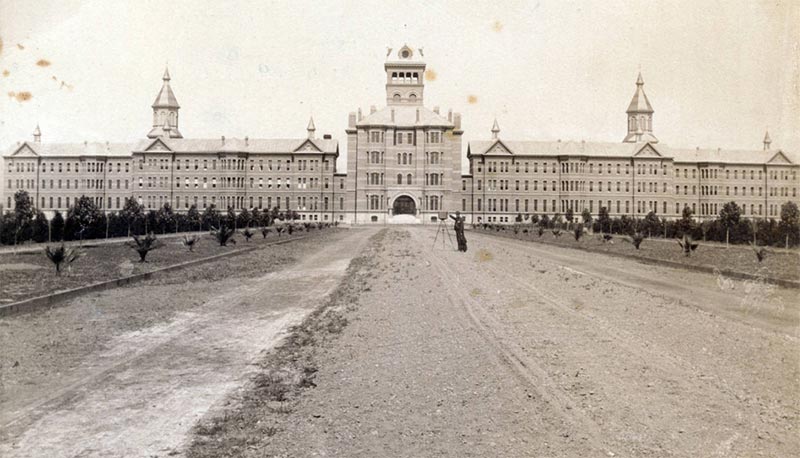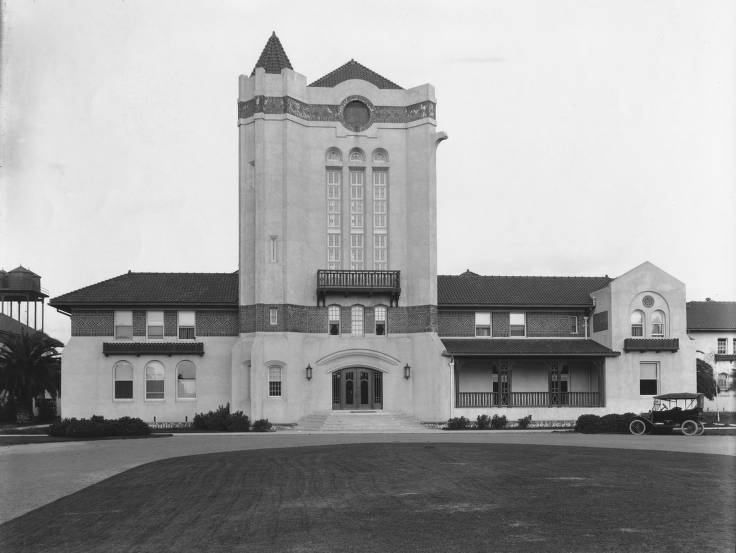This week we are looking back at the Agnews State Hospital. The hospital is most famously known as the site of the greatest loss of life in Santa Clara County after the 1906 earthquake. Eleven officials and over one-hundred patients were crushed when the main treatment building collapsed. But the history of Agnews is more interesting than this grim memory.

Agnews State Hospital, originally known as the “Great Asylum for the Insane,” finished construction in 1888 at a cost of around $750,000. Located in the area known at the time as Agnew Station, Agnews State Hospital was the premier California institution for assisting and treating the mentally ill. The hospital pumped $135,000 annually into the community purchasing local supplies and paying wages to its employees. The architecture of the Agnews’ buildings were designed to not only provide efficient practical patient care as it had claimed, but also to ensure good health and a positive state of mind by designing all rooms to be exposed to the afternoon winds and to be lit by natural light.

Yet, early in the morning on April 18, 1906, residents of the whole San Francisco Bay Area awoke to a violent earthquake. While the destruction to San Francisco is well known, other cities like San José received a great amount of damage and loss of life. The downtown district was hit particularly hard with the near destruction of a dozen or so buildings, including: St. Patrick’s Cathedral, the Phelan building, and the Elks Hall and stores in the heart of downtown. The greatest loss of life in the area however was at the hospital, where the 11 officials and 101 patients perished. News sources from the time stoked a little bit of fear by claiming that, "a number of insane having escaped from the demolished asylum, [were] running at random about the country." While these reports were likely unfounded, the heightened fear of looters and criminals preying on devestated communities could be seen in numerous official documents and public flyers warning the public to be vigilant.
After the earthquake though, the hospital was rebuilt in a more low-rise, Mediterranean Revival style similar to the State Normal School (now San Jose State University). The hospital was then reopened in 1911 as the Agnews State Mental Hospital. The state hospital continued its service to the community until the mid-1970s, when the passage of the Laterman Act (1971) transferred mental health treatment programs to local communities in an attempt to provide better care. This led the state to close many state hospitals throughout the state, including Agnews.

In 1996, the State of California offered up 90 acres of the Agnews land for sale. Through intense community interest, debate, and cooperation, Sun Microsystems purchased the land with the agreement to invest $10 million in the restoration of key historic buildings: including the Clock Tower Building with the clock’s original Seth Thomas mechanisms from 1911, as well as the director’s mansion from 1885. Today, the Angews Developmental Center is utilized by Oracle as a site for research and development. The site has been listed on the National Register of Historic Places since August 13, 1997, as “Agnews Insane Asylum.”
For those interested in reading more about the "Agnews Insane Asylum" and the history of San Jose after the great earthquake of 1906, take a look at the recommended reading below.
Further Reading from California Room
- SJPL's Digital Collections' search for "Agnews"
- Clyde Arbuckle's History of San Jose, by Clyde Arbuckle
- Santa Clara County and its Resources, by the San Jose Mercury News
- Reminiscences of Santa Clara Valley and San Jose, by Amaury Mars
- A Comparative History of Agnews St. Hospital, by Maola McConnel
Also see this FAQ for Patient Information Requests from State Hospitals.
by Mark Robertson


Add a comment to: Looking Back: Agnews State Hospital